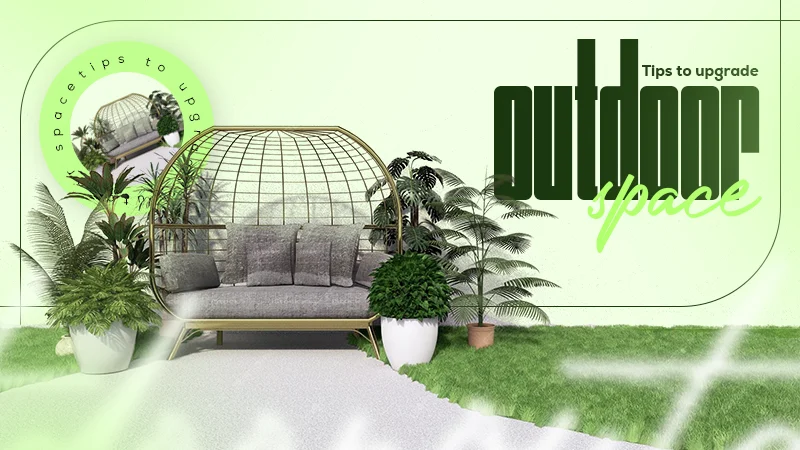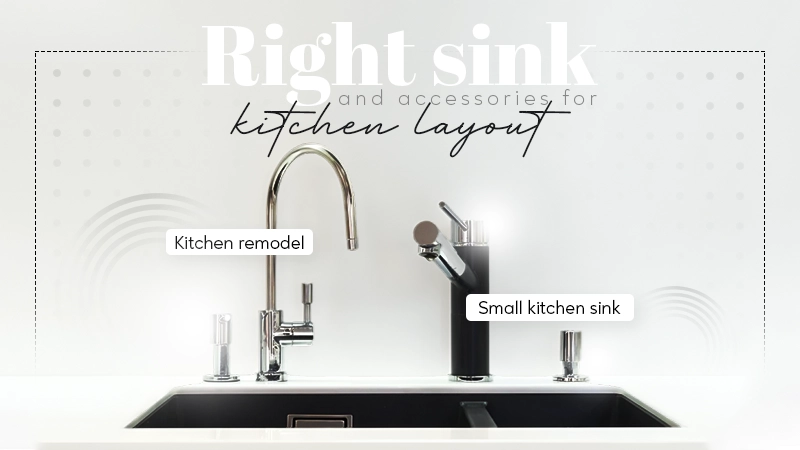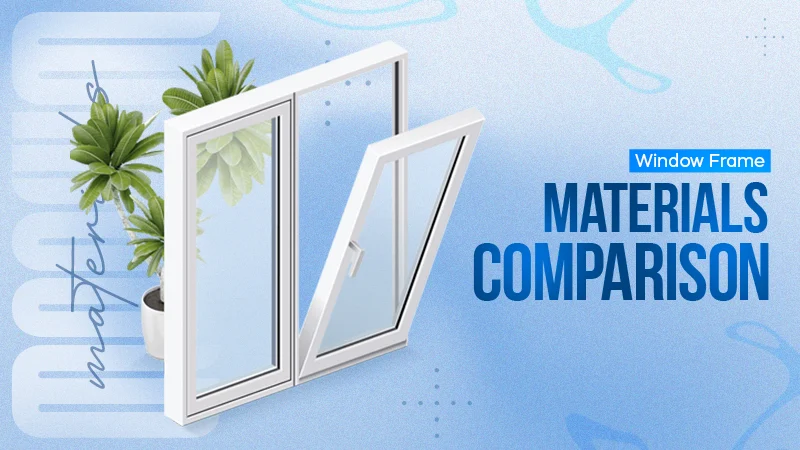Don’t have a vast land for a garden?
Get a spacey jar, add some soil, plant a seedling, and SWISH! Your in-house terrarium is ready!
Today’s article houses the 50 best terrarium plants to restore nature’s touch to your surroundings. These leafy plants are not simply captivating but add a medieval aesthetic to your interiors. Here, I’ll also discuss some tips to care for these plants, so read on!
A Glimpse Into Small Terrarium Plants
A terrarium is simply a sealed glass jar that houses multiple varieties of plants but in miniature form. You can turn any container into a terrarium by adding a specific soil mixture and plant cuttings.
These can be of two types – closed terrariums and open terrariums. A quick explanation of both is given below:
- Closed Terraria are sealed with a lid or cork. This allows humidity to build and grow in the environment. Only certain plants can be grown here, those surviving in high humidity levels, low indirect sunlight, and moist habitats.
- Open Terraria, technically, is not a ‘terrarium’ as it is completely open. It does not have a highly warm or humid environment. On the plus side, it allows more light and, especially, air to pass through. Plants that prefer living in dryer environments with more light can be added here.
Undoubtedly, plants for both terrariums are of different kinds. They’re, more specifically, bought to be grown in a particular environment.
Depending on their growing conditions, I’ve categorized some popular terrarium plants. Learn more about them in the upcoming sections.
Top 22 People’s Favorite Closed Terrarium Plants
Starting with the most favored terraria, let’s list down the plants that can be added to a closed terrarium.
Nerve Plant (Fittonia)
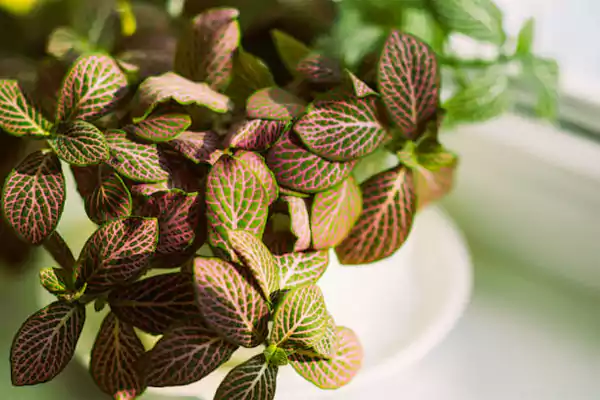
Scientifically known as Fittonia, this genus covers a large variety of plants that differ in color schemes and have eye-catching foliage. The structure of the Nerve plant is mostly the same, and it’s highly appreciated for its varying colors.
Being a plant that favors humidity and low light levels, it is a must-have for closed terrariums. Plus, this buddy is easy to maintain as it is a slow-growing plant that needs compact space.
Fun Fact!
Nerve plants have a dramatic way of letting you know they’re out of water. They faint down to the ground, and just when they receive water, they spring back to life.
Moss (Bryophyta)

Moss, a treasure people find in most areas, has only some value. These little green fleshes are perfect to add texture to your terrarium. The varieties range from sheet moss to clumpy moss and java moss, with each having its own special features.
These plants can easily thrive in a closed area without additional watering. They serve as a perfect cover-up for stones and even compost. Of the varieties, sheet moss is the easiest to set, while the other two can be tricky.
Moon Valley (Pilea mollis)

Since most Moon Valley, aka Pilea plants, prefer a warm, humid atmosphere over direct sunlight, they work well in enclosed terrariums. The moon valley, with its textured green leaves and burgundy veins, is a particularly noteworthy species to try in a terrarium. They remain fairly small, needing only a little maintenance. You can grow them by planting a cutting of around 2–3 inches.
Asparagus Fern (Asparagus setaceus)

This plant turns a terrarium into an actual miniature garden. With its tree-looking frame. Grow them in clayey soil that retains moisture and water them once a week. One thing to note is that these ferns are slightly toxic to humans and animals, which is another reason why they are better off in a closed terrarium. Plus, they usually have tiny thorns that make them a bit hard to handle.
Quick Tip!
Leaves of asparagus ferns can easily turn brown if handled a lot. Ensure to be quick while adding a cutting to the terrarium.
Lemon Button Fern (Nephrolepis cordifolia ‘Duffii’)
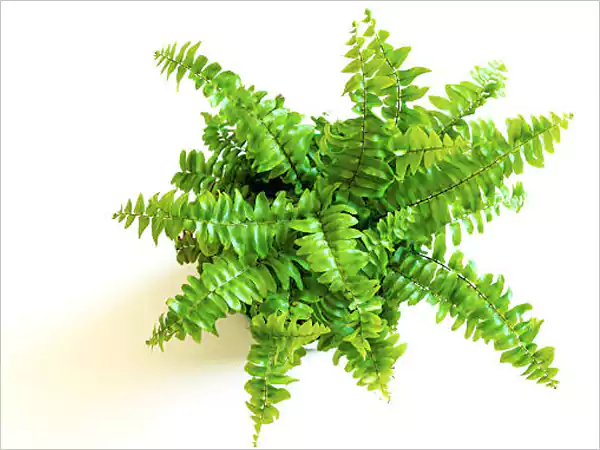
The delicate fronds of lemon button ferns can vary greatly in size, shape, and texture. They are renowned for their funky leaf patterns and soft, feathery appearance. These ferns can add a variety of visual interest to terrarium designs, ranging in color from vivid green to deeper shades.
Its sprawling fronds fit easily into the narrowest spaces and are a great way to add life to a botanical scene. You can divide them further to work with even tinier plants. They require a decent amount of water, so we suggest you combine them with plants like asparagus ferns.
Artillery Fern (Pilea microphylla)

Being members of the Pilea family, Artillery ferns are not actual ferns. They got named so because they shoot seeds with a popping sound that can be heard for quite a distance. Even with that explosive trait, these plants are delicate and have a lovely texture.
Being easy to grow, artillery ferns prefer moisture and humidity, so a closed terrarium is the best place for them to flourish with the least amount of maintenance. Plus, they only ever require water once every 7-10 days.
Radiator Plants (Peperomia)

Peperomia is a huge genus of plants that are born to be in terrariums. Their diversities can be roughly grouped into three categories – vines, large-leaved, and foliage peperomias.
Almost every species has a specific leaf structure that makes it unique. Overall, they are beginner-friendly and do not require regular maintenance. You only need to water them when the soil is completely dry.
Ripple Plant (Peperomia caperata)
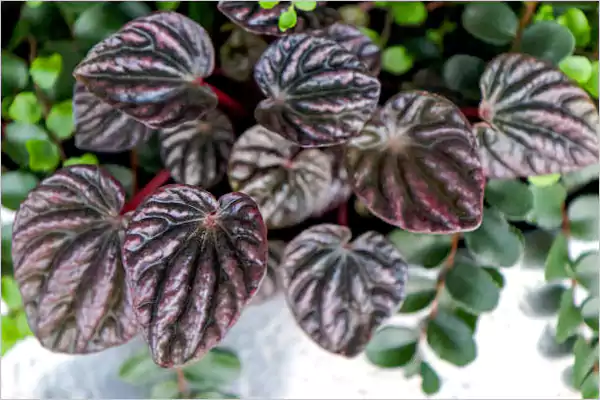
The common ripple plant is known primarily for its deeply ridged leaves that come in a variety of colors and patterns. This small, slow-growing plant does beautifully in closed terrariums where the environment is warm and humid. This species may also produce cool-looking flower spikes adding to the overall looks of this plant. As mentioned earlier, being a peperomia, they don’t require much water.
Arrowhead Vine (Syngonium)

Arrowhead vines come in a multitude of varieties, each with unique leaf colors and shapes. These vines can be a good start for a beginner’s terrarium as they require little maintenance, less water, and extremely low light.
Syngonium, being vines, will eventually outgrow their space, but they can be easily trimmed back to size. Alternatively, you can go for Syngonium ‘Pixie,’ a more compact, variety with green and cream-white leaves.
Strawberry Begonia (Saxifraga stolonifera)

Strawberry begonia, a creeping plant with spherical, olive-green leaves speckled with silver, is confusingly identified as a saxifrage rather than a begonia. Known as the ‘mother of thousands,’ a single plant grows slender shoots that support the growth of ‘baby’ plants along their length.
This particular plant has tiny, delicately scented pink-white flowers. The compact growth and low water requirements make it a fantastic choice for terrarium plants. Soon after planting, it will cover the base, acting as a foil for other plants.
Pothos (Epipremnum aureum)
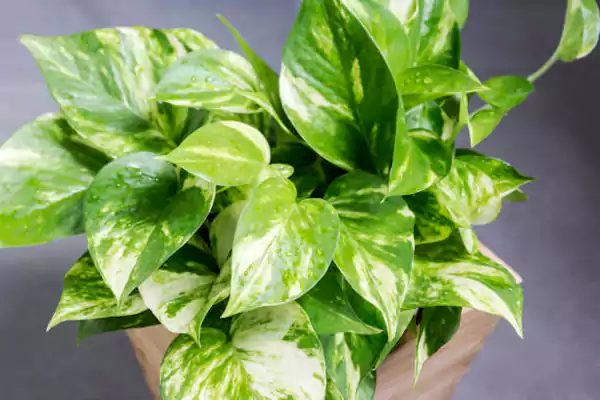
Pothos are known to be beloved houseplants. What’s shocking is that they are terrarium-friendly too! However, these little kids grow up quite fast and might just get invasive in other plant areas. Thus, some kinds are better preferred by planters for their tropical habitat.
Varieties like Manjula, Njoy, and Pearls & Jade Pothos are usually more appropriate for a small terrarium since they are slower growing, more compact, and have shorter leaf internodes. You can add them in a terrarium that you water once a week.
African violet (Streptocarpus)

African violets are a great option for a closed terrarium as they do well in indirect light, high humidity, and free-draining compost. Since they can retain moisture and grow mold, their leaves must not come into contact with the glass’s edge.
Thus, to achieve the best results, make sure your terrarium has enough space for the African violet to flourish. Try to place it in the center of the display, surrounded by other plants, to reduce the chances of its leaves spreading into the glass. Only water the plant when the soil is completely dry.
Polka dot plant (Hypoestes Phyllostachya)

Polka dot plants come in a lot of variations, but one thing is common in all– color patches. These patches, ranging from pink to ivory and white, cover the leaves giving them a vibrant look. This leafy buddy loves humidity, grows slowly, and has short leaf internodes, which makes it a good option for closed terrariums.
Remember that these pink delights tend to grow towards the region receiving more light. Thus, plant them on the brighter side for better growth. Only water the terrarium once a week.
Earth star plant (Cryptanthus bivittatus)
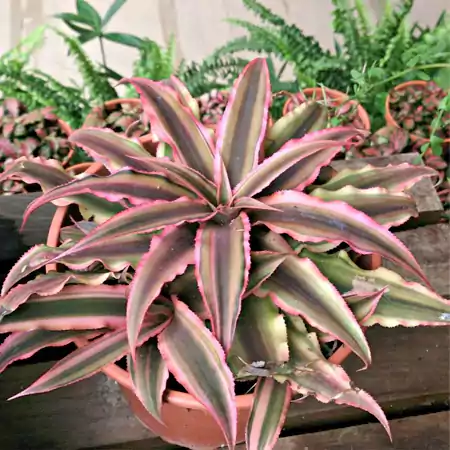
Native to the Brazilian forest floor, the earth star plant is a type of bromeliad with a flat rosette of lush foliage that comes in shades of green, red, and purple.
Because of its outward growth habitat, instead of growing upward and outgrowing the available space, it is ideal for terrarium displays. The earth star plant likes bright but indirect sunlight, warmth, and humidity, just like any other plant that grows in a closed terrarium environment.
Creeping Fig (Ficus pumila)
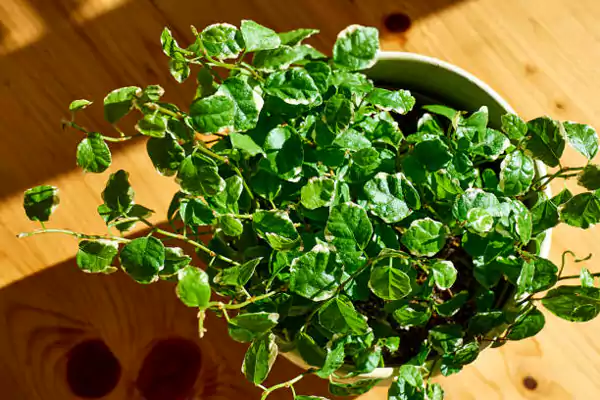
The heart-shaped, fresh-green leaves and the delightful creeping fig will quickly cover the ground in your terrarium. When that’s done, you might even see it creep up the sides of the glass.
With high humidity being its favorite, it does better in a closed terrarium than as a typical open houseplant. Although it does not prefer direct sunlight, it surely is a fan of receiving more light than other plants. However, the soil should always remain moist.
Fun Fact!
To grow this plant in your terrarium, you don’t even require planting. Simply drop a cutting in the jar wherever you like, and the job is done!
Jewel orchid (Ludisia)

Among the multiple varieties of jewel orchids, Ludisia discolor is known to be the easiest species to grow. With its olive green leaves striking with creme and pink stripes, this plant will always stand out in your display.
In addition to stunning foliage, Ludisia produces a solitary white flower spike that appears once a year. Being exposed to bright light can cause its leaf to turn pink, thus, always shade this plant with other ones. Provide the plant with a moist compost for best results.
Miniature Begonia (Begonia cucullata)

Miniature begonias, adorned with beautiful and colorful foliage patterns, flourish greatly in humid climates. Given their small size and less water requirements, they are an excellent option for enclosed terrariums.
To enhance their visuals, they often grow into complex patterns with swirls, spots, streaks, and veins. Lastly, if you’re lucky they might just give you a flower or two, in a terrarium too.
Aluminum Plant (Pilea cadierei)
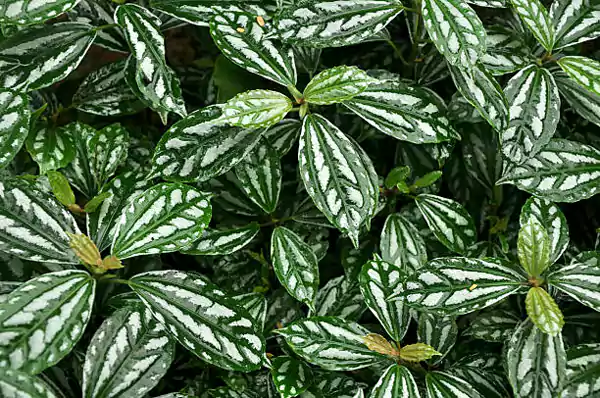
The popular Aluminum Plant, also referred to as the Watermelon Pilea, is prized for its eye-catching foliage and low maintenance requirements. The distinctive leaves of Pilea cadierei are highly valued for their unusual pattern, which reminisces of aluminum markings or watermelon rinds.
Typically oval or elliptic in shape, the leaves have a bushy, compact growth habit. Being a slow grower, it is perfect to fit in a terrarium.
Miniature English Ivy (Hedera helix)
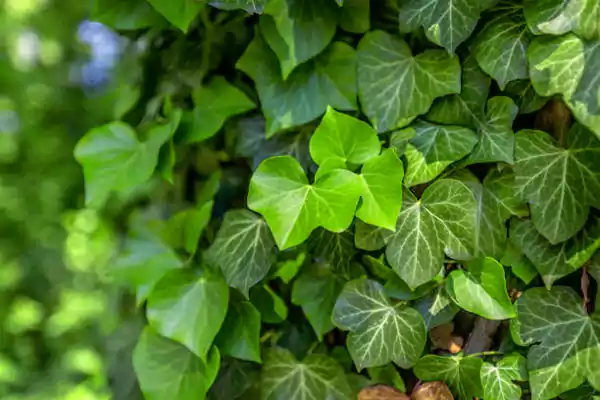
Miniature English Ivy (Hedera helix), perfect for small terrariums, can thrive in both open and closed terrarium environments, making it versatile and easy to care for. It’s a beautiful, low-maintenance option that adds lush greenery to your miniature tropical climate. However, this plant prefers being consistently moist, so don’t forget to water it every two to three weeks.
Baby’s Tears (Soleirolia soleirolii)

Baby’s Tears is a lush green plant that produces clumps of baby leaves attached to a thin branch. The leaf clusters have a flower-like appearance, making it a perfect plant to add beside the glass wall.
As a houseplant, it is one of the low-light hanging plants that creep down. However, this plant can easily thrive in the moist environment of a closed terrarium with less water. You can combine this vine with plants like miniature ivy, artillery ferns, and polka dot plants for a powerful display.
Miniature Orchids (Phalaenopsis)

Miniature orchids are a huge genus in itself, containing a collection of tiny orchid species. They come in varying sizes, colors, and structures, but every plant is compact and slow-growing. These flowering buddies are the best option to add a tint of color to your terrarium.
Besides being tiny, they are also highly resilient to humidity and low light levels. These plants are so friendly, they can be combined with any variety, even succulents, and still thrive. Given their adaptable nature, they will adopt any watering routine you provide.
Miniature Snake Plant (Dracaena trifasciata hahnii)

Miniature snake plants, better known as Dwarf snake plants, get their name from the scale-like leaves they produce. The leaves, growing in a rosette pattern, have light-colored stripes, resembling that of a snake. With a thrill for indirect sunlight, they like being on the brighter side of the terrarium. All the while, they require a little more water to maintain their flesh.
Moving on, let’s explore some humid-intolerant plants in the subsequent section.
Top 18 People’s Favorite Open Terrarium Plants
Plants chosen for open terraria are those that thrive in partial sunlight and a less humid environment. Take a look at a few such plants that are widely loved by planters.
Air plants (Tillandsia)

Being the easiest growing plant, these intriguing plants can survive in the air, without soil. As epiphytes in the wild, they cling to a host and take in nutrients and moisture through their leaves. Therefore, air plants make great low-maintenance plants for an open terrarium.
You can drop a rooted leaf on a stone or piece of wood, they will easily wrap themselves around it. Just remember to take the air plant out of its terrarium once a week to water it—you can spray or submerge it in a bowl of water.
Mexican snowball (Echeveria elegans)
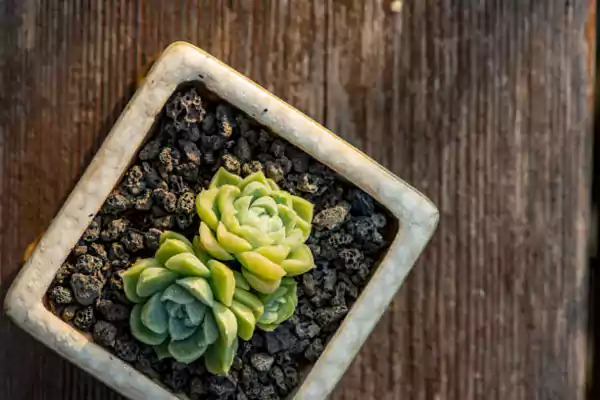
Mexican snowballs, one of the most famous Echeverias to grow, are the best succulent to grow in a terrarium. With its rosette structure, it gives off a flower-like appearance, making it stand out among other plants.
These fleshy buddies, requiring little water, can be paired up with their best pals cacti, and other succulents. If lucky, you will also be surprised with small yellow flowers. Snowballs prefer free-draining pebbles with plenty of light, so keeping them beside a window is preferred.
Cacti (Cacti)
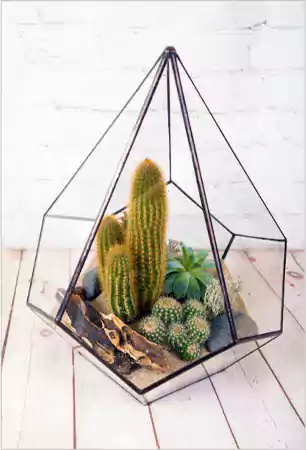
Cacti is a huge genus full of thorny plants that require little to no care at all. These sharp-toothed pals can come in different shapes and forms, from a tall cucumber-like look to a short tennis ball one. The spike structure, density, and sharpness vary with every species.
You can easily create a desert-themed terrarium by filling it with sand and adding in some cacti varieties. Remember that cactus prefers constant airflow to keep the humidity away, so use a big-mouthed terrarium.
Quick Tip
Despite being a repel for humidity, they still require regular water, when kept in a terrarium.
Jade Plant (Crassula ovata)

Like any other succulent, Jade plants thrive in open terrariums. However, they require frequent watering, so avoid adding them with cacti. If you are a proficient bonsai artist, you may wish to train your jade plant to grow into a small tree. The trumpet-shaped leaves of Crassula Ovata aka Jade plat give it an intriguing appearance.
Button fern (Pellaea rotundifolia)

Button ferns are a species of ferns that prefer dry environments, thus, they are highly recommended for an open terrarium. Their name comes from their distinctive round, button-shaped leaflets growing from a thin straight stem.
These plants are relatively low-maintenance plants in terms of care. They prefer to be kept close to a window for some bright, but indirect light. These ferns are a hassle-free option for terrarium plants as they don’t require watering until the top inch of soil has dried out.
Haworthia (Haworthia)
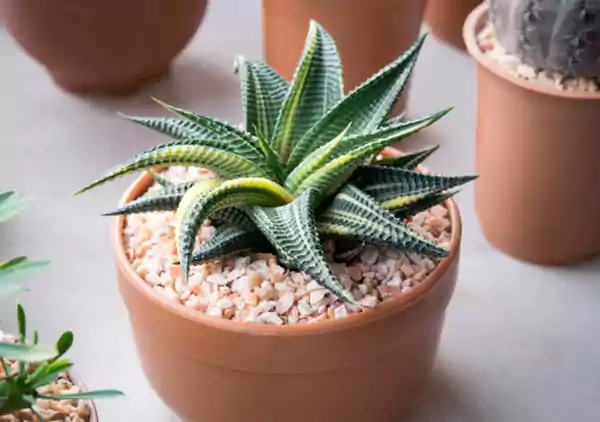
Haworthias are slow-growers and need very little watering, which makes them great plants for an open terrarium. Additionally, they are available in a wide range of shapes and colors making them a fantastic focal point for a display. Typically, Haworthia plants have spiral-shaped rosettes of thick, fleshy leaves. For the best results, place your terrarium next to a window that lets in plenty of indirect light.
Venus Flytrap (Dionaea muscipula)

Carnivorous plants prove to be a great option for terrariums, especially for their unique structure. The Venus flytrap is a particularly well-liked option because of its small size. Being in an open terrarium will make it easier for them to consume insects and survive. However, you can also add them to a closed terrarium that can be opened when needed.
Ox tongue (Gasteria batesiana)

Gasterias get their common name from their paired, smooth leaves that resemble the tongue of an ox. They look great in terrariums with stones and can be mixed in with other succulents to create a larger display. While it can tolerate less light than other succulents, Gasteria still prefers bright, indirect light. Grow it in a substrate or compost that drains freely, and provides frequent watering—ideally right before the soil dries out.
Buddha’s Temple (Crassula pyramidalis x Crassula perfoliata)
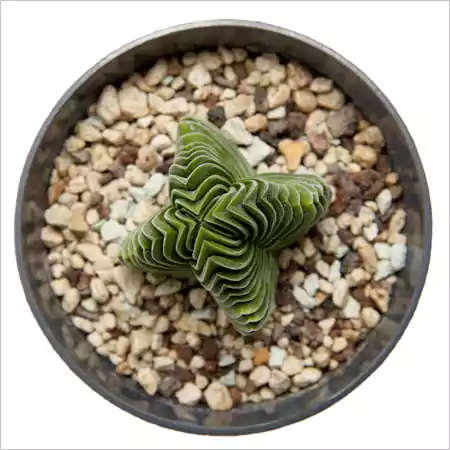
This unusual, striking succulent is ideal as a centerpiece, thanks to its upward-facing leaves, giving the appearance of a Chinese temple. For this terrarium plant, pick a sunny spot and use minimal watering.
A light liquid feed should be applied every two weeks while the plant is young. If you grow it with other succulents, bury it in the soil with its original small pot. This will ensure the safety of other plants in the arrangement while feeding it.
Burro’s tail (Sedum morganianum)
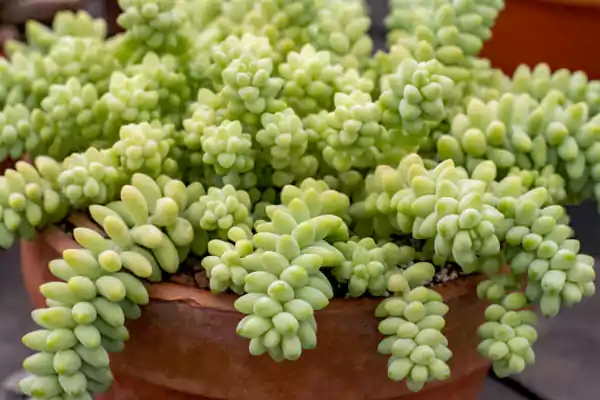
The name ‘burro’ comes from the impressive string of succulent leaves that resembles the tail of a donkey. If allowed to grow naturally, a burro’s tail can eventually sprout into a long branch that extends outside of the terrarium. However, if kept in shape, its unique growth habit can add extra depth to the display. Add burro’s tail to a free-draining potting mix in a warm, well-lit spot, along with any other succulents or cacti.
String of Pearls (Senecio rowleyanus)

String of pearls, as the name suggests, adds a lovely touch to any open terrarium with its delicate, spherical leaves that trail like a cascade of beads. This beady plant requires soft bright light, thus, adding them at the glass corner would be perfect. You can choose to trim the plant when the branches begin to hang out of the terrarium. Water them only when the soil is partly dry.
Chinese Money Plant (Pilea peperomioides)

Different from a basic money plant, the Chinese money plant features round, funky leaves. Every branch ends with a single large leaf, giving off a playful aura in the surroundings. This plant dislikes being soaked, so it should be watered only when it is partly dried out. They prefer indirect light over burning sunlight, so keep them near a window but at a distance.
Stonecrop (Sedumspp.)
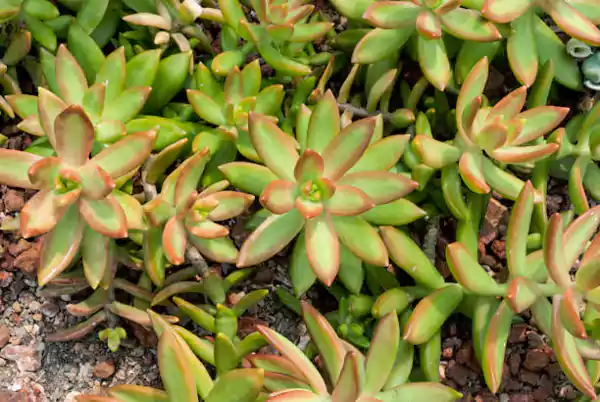
Stonecrops, or sedums, are adaptable succulents that come in a variety of shapes and sizes. They are excellent for giving your terrarium an extra depth thanks to their frequent trailing growth habits. Although they can withstand a variety of lighting conditions, Stonecrops usually prefer bright light. Remember to let the soil dry partially in between waterings.
Hens and Chicks (Sempervivum tectorum)
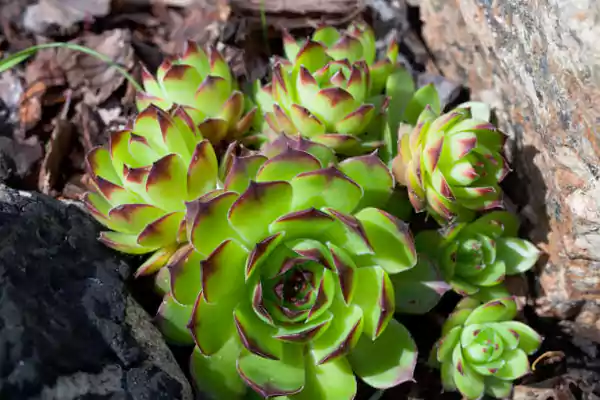
Hens and chicks are among the best kinds of succulents for an open terrarium with their tiny rosettes and offshoots. Combine this variety with other tiny desert plants, such as Mini Jade or Hobbit jade plants. Since the plant can withstand drought, keep it in a bright place and let it dry out in between waterings.
Living Stones (Lithops spp.)
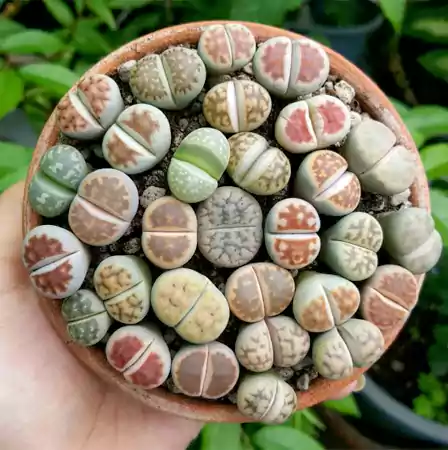
Lithops, also known as living stones, are excellent for open terrariums because of their compact size. Their distinct form and rock-like appearance will give any terrarium area a whimsical touch. These bizarre-looking plants produce colorful flowers in the fall and winter that will liven up your terrarium. They thrive best in soil that drains well and with sparing watering, just like all other succulents because they are sensitive to overwatering.
String of Turtles (Peperomia prostrata)
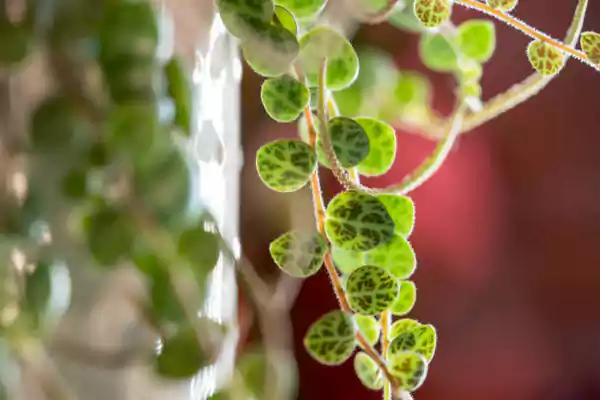
Given its compact size, shallow roots, and spreading growth habit, the string of turtles is ideally suited for open terrariums. Its succulent-like leaves are easily prone to being overwatered, thus water levels should be maintained. That being said, they should still be combined with other tropical plants rather than succulents.
Pixie Lime (Peperomia orba)
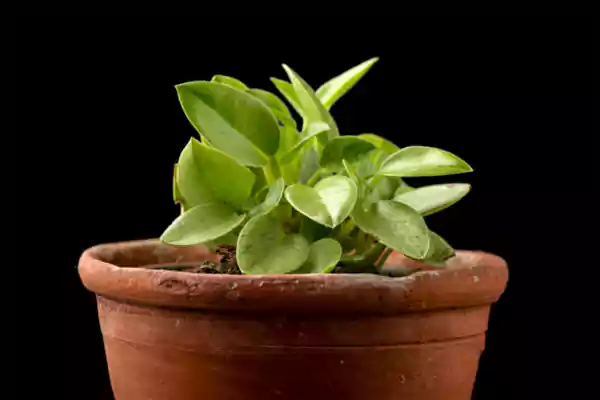
Pixie lime is adorned with bright green leaves forming a compact plant structure. For its tolerance of both low and high humidity, it works well in both closed and open terrariums. Being semi-succulent, it needs to dry out a little between waterings, thus, you can easily pair it up with other succulents. Pixies, when provided the favorable conditions, produce interesting-looking flower spikes to liven up your terrarium arrangement.
Spiderwort (Tradescantia)

Tradescantia are tropical plants that are hardy and simple to cultivate. They create dense mats by growing roots whenever a part touches the ground. These pinkish pals come in several light-foliage varieties that have striking dark purple undersides. Although spiderwort prefers continuously moist soil, it can tolerate brief dry spells and will re-emerge when watered.
Till now, you have all witnessed plants that are small in size, and perfectly suited for miniature terrariums. But who said terrariums have to be small? Read below to learn about some of the large terrariums that can instantly enhance your living space.
Best Plants for Terrarium (Large Version)
With their long, bushy leaves and unique texture, large terrarium plants are definitely worth adding to your interior decoration! Here are some large terrarium plants for inspiration:
| Plant Name | Image |
| 1. Spider Plant(Chlorophytum comosum) |  |
| 2. Prayer Plant(Maranta leuconeura) |  |
| 3. Golden Pothos(Epipremnum aureum) | 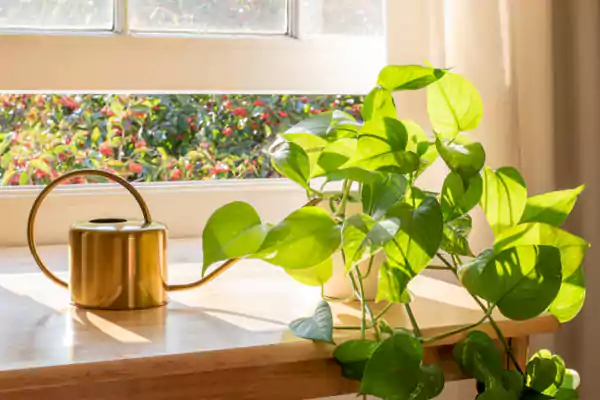 |
| 4. Spike moss(Selaginella) | 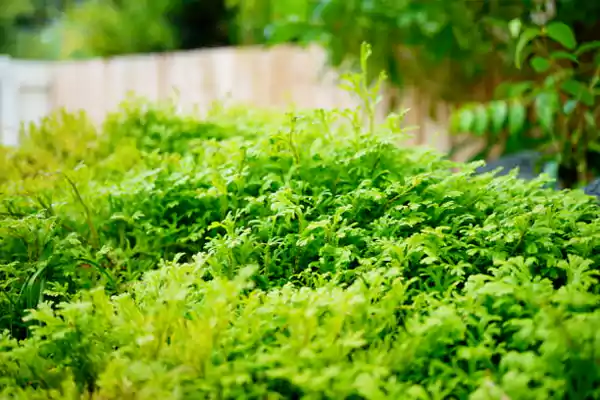 |
| 5. Calathea(Calathea spp.) |  |
| 6. Croton(Codiaeum variegatum) |  |
| 7. Rattlesnake Plant(Calathea lancifolia) | 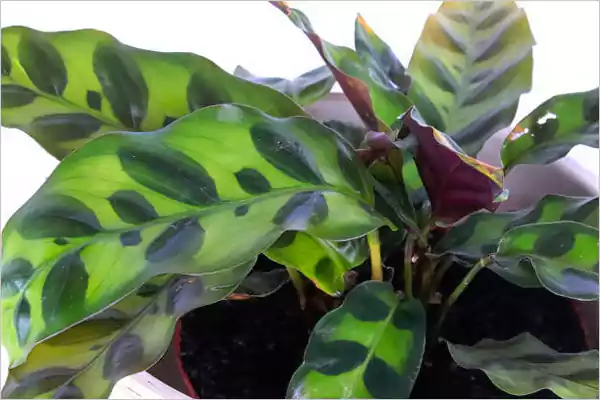 |
| 8. Neanthe Bella Palm(Chamaedorea elegans) |  |
| 9. Maidenhair Fern(Adiantum pedatum) | 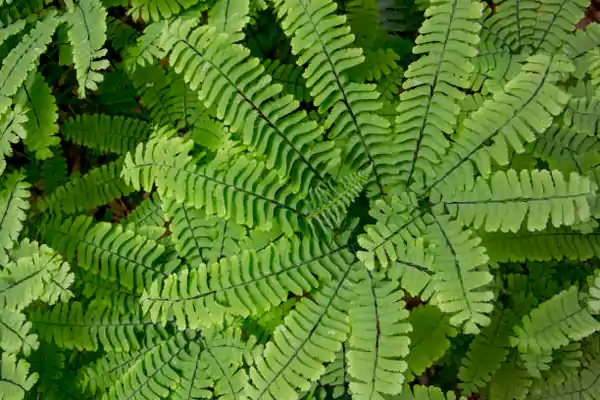 |
| 10. Elephant’s Ears(Alocasia) | 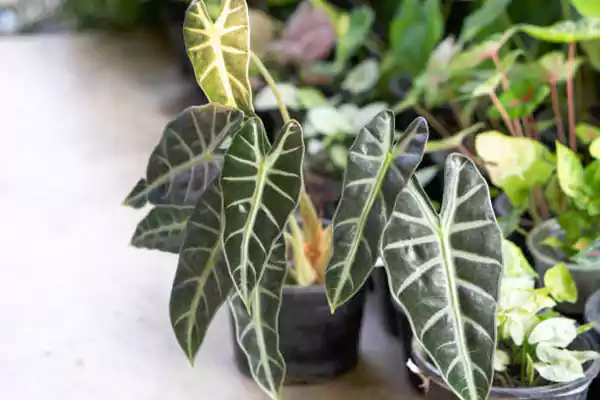 |
If you’ve loved the idea of crafting terraria, you can put your time in filling up a larger glass container. You can purchase such containers at a local Target branch or online. Some commonly purchased jars are Demijohn Terrarium Glass Vase and Ferrisland Glass Terrarium Greenhouse House Shape.
Tips to Take Care of Plants for a Terrarium
Building and maintaining a natural habitat, despite the size, can be a challenge. Taking care of a single terrarium is no different from caring for a whole garden.
Therefore, I’ve mentioned a few tips to prevent you from making an uncanny mistake. Who knows, they might just answer the questions in your mind, too.
- A closed terrarium cannot attract bugs, but an open one can, especially due to overwatering. Thus, you need to get rid of such gnats from your houseplants, regularly.
Additional Info
If you notice bugs in a closed jar too, then it is likely that either the soil or the plant carried the bugs from the start. Always check both before adding to the terrarium.
- Avoid adding succulents or desert plants in a closed terrarium. These should only be planted standalone in an open jar filled with dry rocks and pebbles.
- Watering should be as per the moisture level required in a terrarium. A closed one should only be watered once in 2-3 weeks while you can water the open ones every week.
Additional Info
An exception will be Air plants (Tillandsia) that need to be watered regularly.
- Use a specific terrarium or succulent/cactus soil mix since it allows for adequate drainage and reduces the chance of excessive moisture buildup.
- Closed terrariums do not require fertilization, while open terrariums can benefit from a small amount of diluted liquid fertilizer throughout the growth season.
Terrarium Plants to Get and Avoid – For Beginners
Besides everything, there are a lot of beginner-friendly plants. On the contrary, there are a few that they should straight-out avoid. Here’s a table showing plants of both categories.
| Plants to Choose | Plants to Avoid |
|---|---|
| Nerve Plants (Fittonia) | Clumpy Moss (Leucobryum glaucum) |
| Arrowhead Vines (Syngonium) | Java Moss (Taxiphyllum barbieri) |
| Pothos (Epipremnum aureum) | Prayer Plants (Maranta leuconeura) |
| Pilea | Jewel Orchids (Ludisia discolor) |
| Button fern (Pallaea rotundifolia) | Air Plants (Tillandsia) |
| Creeping Fig (Ficus pumila) | Venus Flytraps |
| Peperomia | Jade Plants (Crassula ovata) |
| Spikemoss (Selaginella) | |
| Polka Dot Plant (Hypoestes phyllostachya) | |
| Hypnum Moss (Hypnum cupressiforme) |
Closing the Jar!
A terrarium is like a whole new world encapsulated in a jar. While making one, you bring out your inner creativity, which results in a beautiful tropical habitat full of diverse plants.
Whether it’s a closed terrarium or an open one, both have their qualities and a fair share of admirers as well. Undoubtedly, these bottle gardens will bring nature’s spark to your home, that too in miniature form.
What kind of plants are best in a terrarium?
For closed terrariums, Fittonia, mosses, and several types of ferns are a great option. On the other hand, you can choose air plants, cacti, and succulents for open terrariums.
What is needed for a plant terrarium?
There are a few things you will require to build a terrarium from scratch:
- Container with no drainage holes (Usually made of glass).
- Terrarium-friendly plants.
- Sheet moss (or any moss you prefer).
- Gravel or beach stones (mostly for open terraria).
- Activated charcoal (found at a nursery).
- Sterile potting mix without perlite or vermiculite.
Can any plant survive in a terrarium?
Not all plants you find in your environment can be planted in a terrarium. Some plants that are resistant to high humidity and low light can survive in closed terrariums. Meanwhile, some prefer medium to low humidity levels and can grow in open terraria.
What do you put in an open terrarium?
Open terrariums can feature several plants, depending on their size and position. The most famous varieties include cacti, air plants, and almost all species of succulents. You can also add other ones like a Chinese money plant, pixie lime, and string of turtles.
Make your own terrarium by Kew.org
Terrariums by Wikipedia




